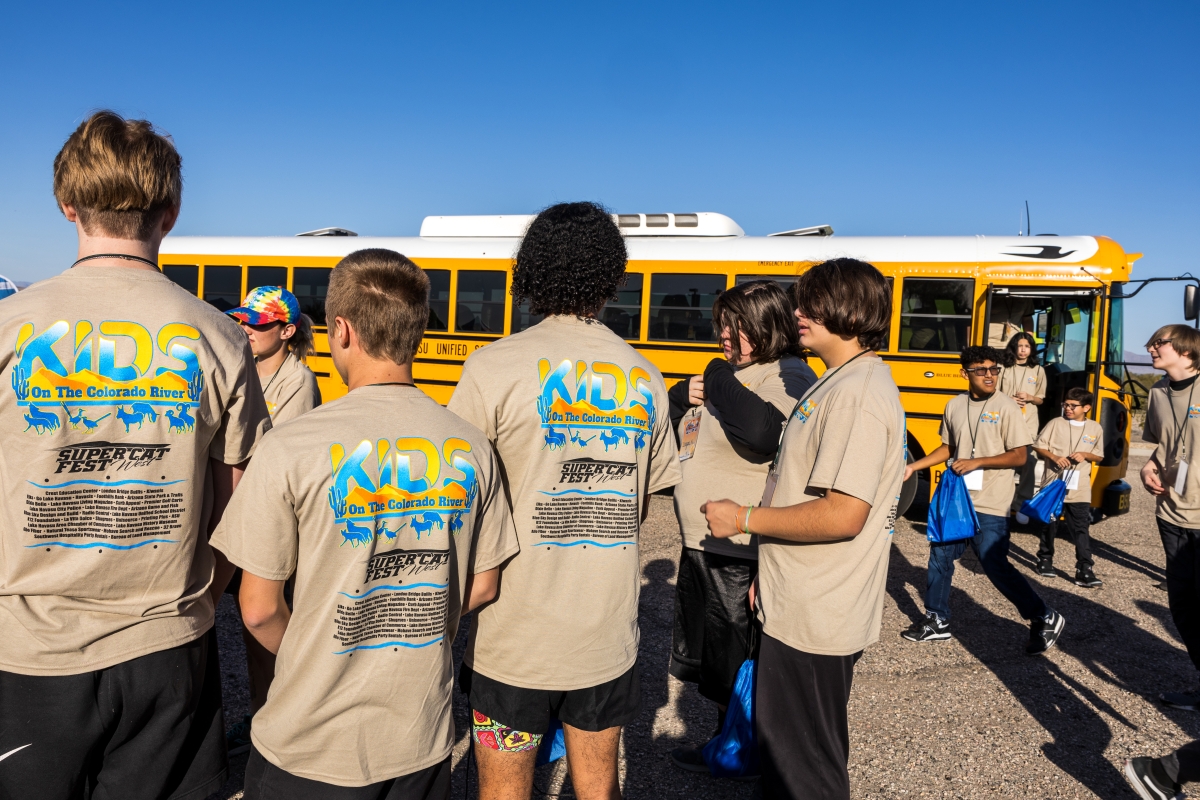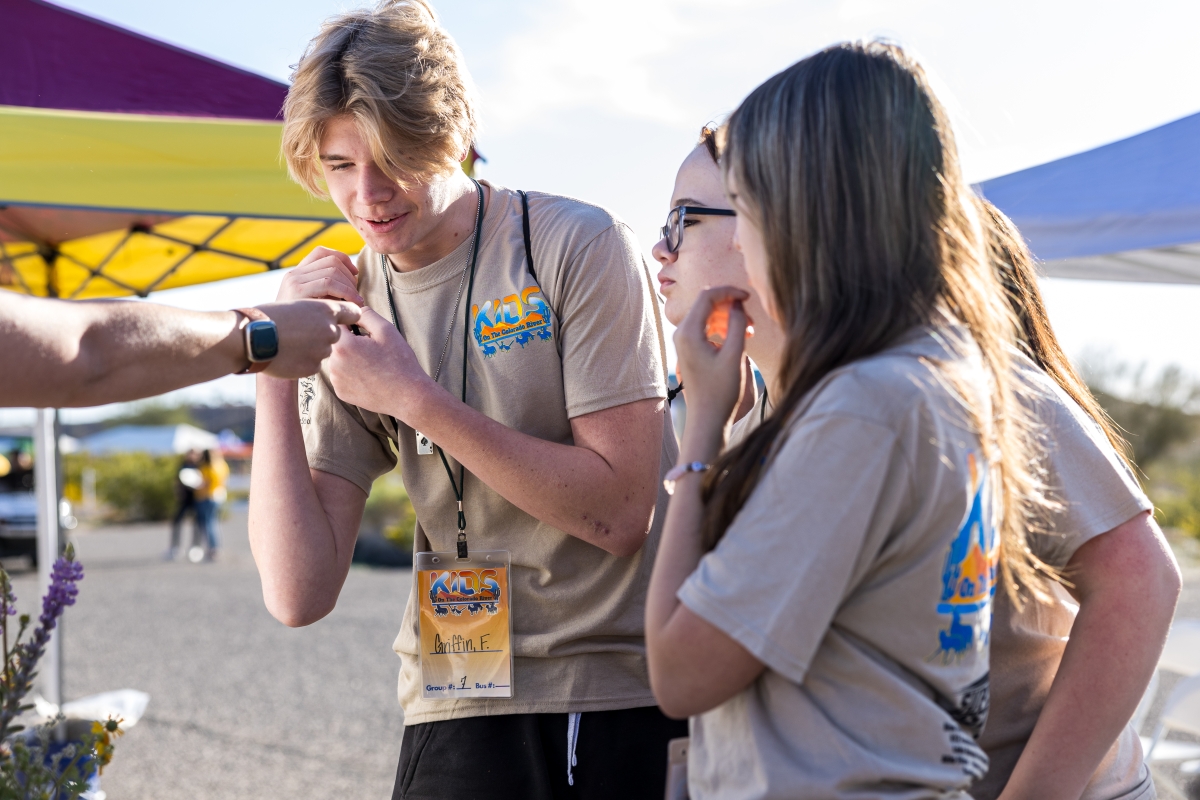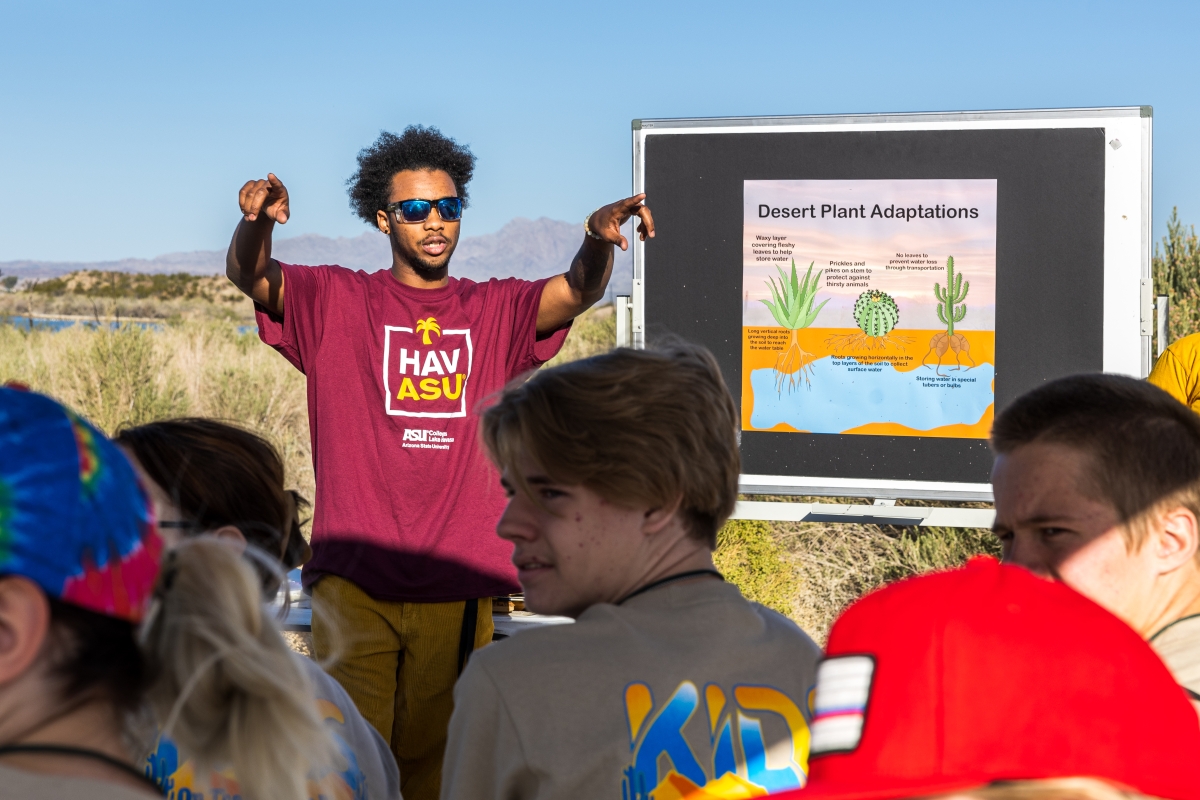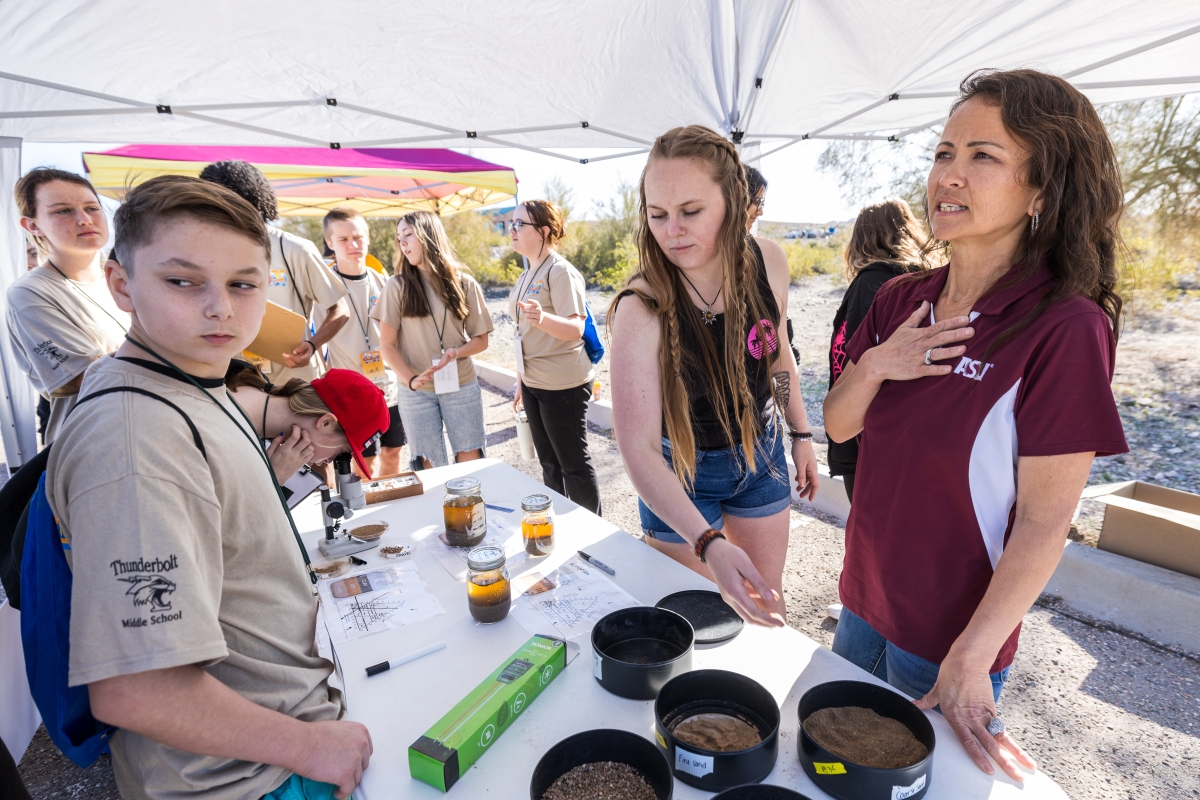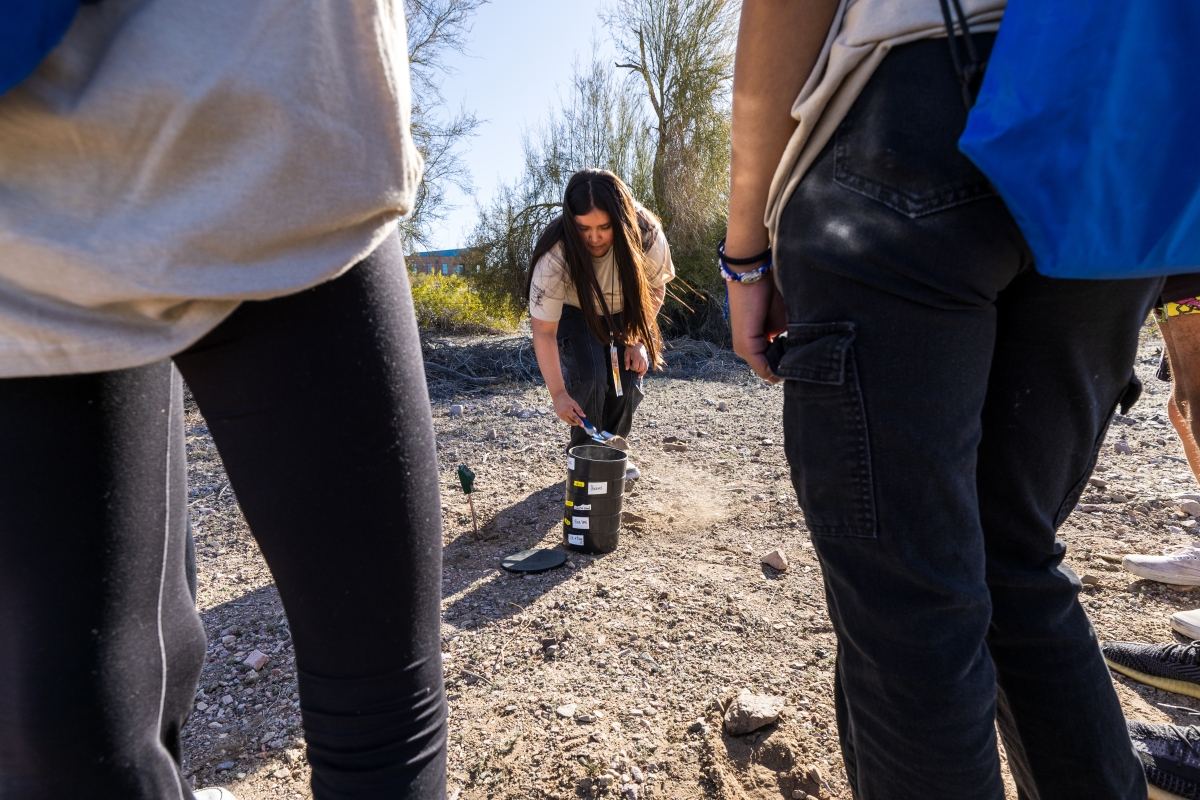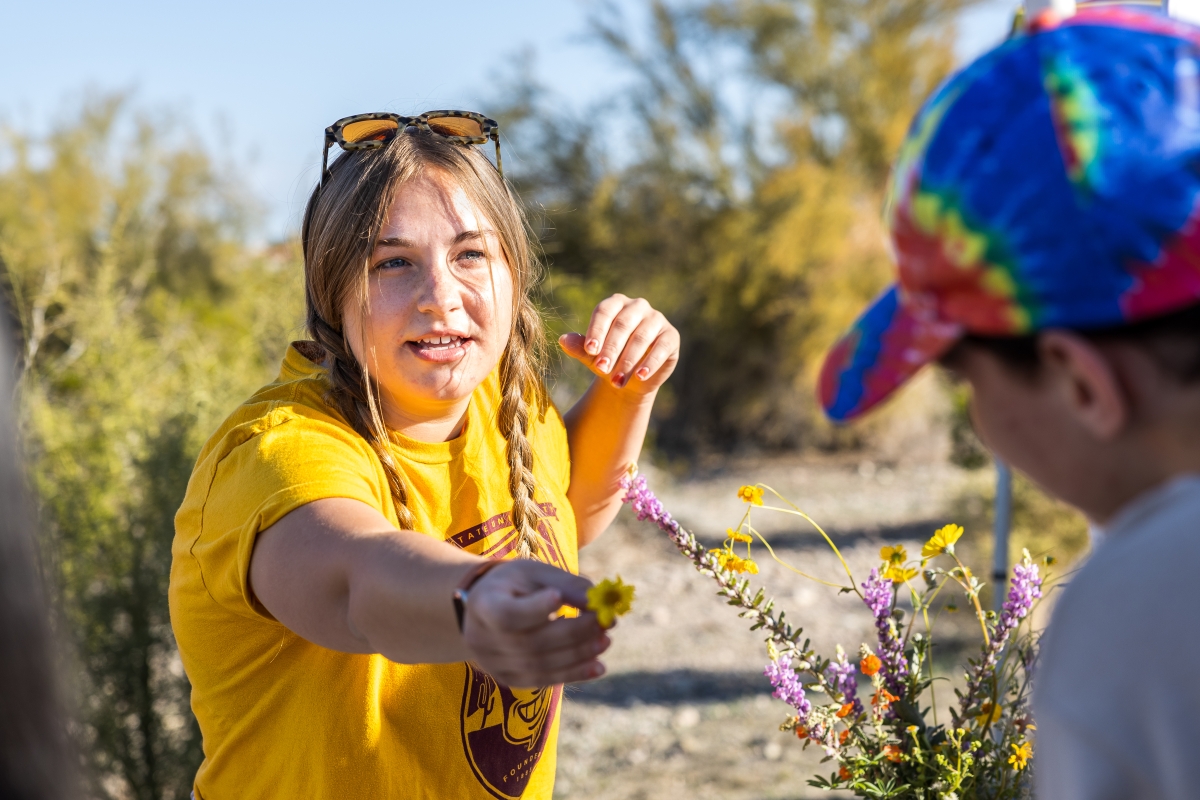Colorado River becomes an outdoor classroom for these middle school students
ASU at Lake Havasu staff, students teach eighth graders as part of 'Kids on the Colorado River Project'
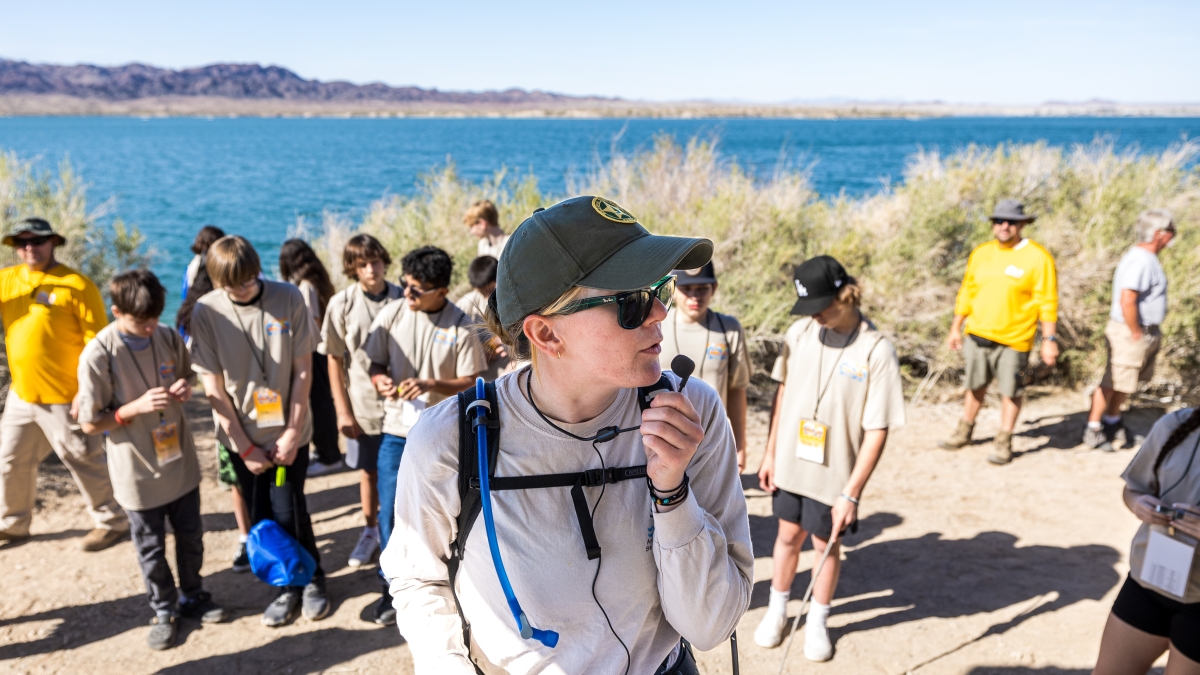
ASU at Lake Havasu environmental science graduate and current Arizona State Parks ranger Jenni Burdick leads eighth graders from the Lake Havasu Unified School District on a nature walk to learn about the habitats and ecosystems in the Colorado River area as part of the Kids on the Colorado River Project. Photo by Charlie Leight/ASU News
Griffin Freburg doesn’t usually look forward to science class.
But on a sunny day in March, the eighth grader changed his tune. Concepts that were usually explained in long paragraphs in a textbook or by a lecture now came alive in nature.
The Colorado River and its surrounding desert was his new classroom and instructor for the day.
“There are certain subjects — like math and science — that are kinda hard for me,” said Freburg, who attends Thunderbolt Middle School in the Lake Havasu Unified School District. “I've always been a big fan of nature. So, spending time out in the wild and learning about this stuff is gonna be really cool.”
Freeburg was one of approximately 375 middle school students who participated in the Kids on the Colorado River Project, a full-day field trip hosted by staff and students at ASU at Lake Havasu to give middle school students at the Lake Havasu Unified School District hands-on outdoor lessons on the banks of one of the region’s most precious resources.
“The Kids on the Colorado education project hopes to inspire the next generation of civic and environmental stewards of our community and state through hands-on outdoor lessons just feet away from the lake,” said Jeanette Nangreave, assistant research professional, an instructor at ASU at Lake Havasu, and an inaugural member of the board of directors of the Kids on the Colorado River nonprofit organization.
“Helping our children to form connections to the water will encourage them to stay in our community and grow into thoughtful guardians of our state’s natural resources,” she said.
Small groups of students were escorted through seven educational experiences timed at 19-minute intervals — each related to areas like outdoor pursuits and recreation on the lake; the human and natural history of the area; civic responsibility and safety; biological/chemical/physical measures of soil quality; ecology; natural resource management; and more.
These interactive experiences were led by volunteer experts from local, state and federal agencies such as Arizona State Parks and Trails, the Bureau of Land Management, Mohave Search and Rescue, Arizona Game and Fish Department, and ASU at Lake Havasu.
Mike Peters, a general contractor in the region and co-founder of the event, said he camped on the lake as a young man in the late 1960s and learned an appreciation for nature.
“I grew up on this lake, camped and slept on the beaches, waterskied and did just about anything you can do on this lake,” Peters said. “We watched monsoons, learned about the water, sand and wildlife. No one taught us about it. We just learned it on (our) own.”
Peters noticed when he moved back to Lake Havasu City in 2019 that the younger population wasn’t taking advantage of or enjoying the water. One day he asked his wife, a schoolteacher, if she would take an informal poll of her fifth-grade class. He specifically wanted to know, out of the 30 or so students, how many went out on the lake for a day of fun?
“I found out that only two of them did. So, I was like, ‘OK, this has to change,’” Peters said. “Everybody just assumed that people took advantage of what the lake had to offer. Nobody understood the magnitude that about 80% of the kids in Lake Havasu City don’t know how to walk around the desert, what to do on the lake or made sense of the rock structures.”
Peters visited a contact at the Lake Havasu City Chamber of Commerce, who put him in touch with several agencies, who immediately bought in. Peters and another Havasu local, Dan Delasantos, then went to every service club in town — making presentations and asking for volunteers and money. Through their support, Peters and Delasantos were able to put the program together in a short amount of time.
One of the first to offer support was Lake Havasu State Park Director Dan Roddy, who oversees 33 properties throughout the state.
“I saw it as an opportunity for engagement at an early level,” Roddy said. “Once students hit high school age, they’re already thinking about a career. But at the middle school level, you can still spark a student’s interest. Maybe they want to be a park ranger. Or perhaps they want to get involved with the Wild Horse and Burro Program with the Bureau of Land Management. Or outdoor recreation and campgrounds. We offer a little bit of everything.”
Roddy then reached out to Nangreave from ASU at Lake Havasu to get buy-in from the university.
That opportunity was a lure for Jenni Burdick, who graduated from ASU at Lake Havasu in December with a degree in environmental science and is currently a ranger for Lake Havasu State Park.
“I came to Lake Havasu two and a half years ago and was studying aerospace engineering at the ASU Tempe campus when COVID-19 hit,” said Burdick, who offered guided tours to students around the Lake Havasu peninsula. “I realized I didn’t want to be in a lab all day. I wanted to be out in the environment. I kinda fell into this, but I love it. I can’t see doing anything else.”
During the field trip, she offered her perspective to students.
“I think it’s very important to teach our youth about the environment so that future generations can appreciate this landscape,” Burdick said. “They tend to get more hands-on learning when they’re out in the wilderness, understanding how organisms and species exist out here. It beats being in a classroom and being talked to.”
Kerrie Anne Loyd is used to teaching biology and ecology classes for ASU at Lake Havasu in the outdoors. Her research on the western burrowing owl has brought her international acclaim. But on this day, her environmental education focused on desert ecology versus river ecology.
“I want to give these students an appreciation and understanding about the difference between native and invasive plants, and how invasive plants can harm our ecosystem,” said Loyd, a wildlife biologist at ASU at Lake Havasu. “In a 19-minute session, we discuss desert plant adaptions, what are all the ways that plants have to survive in this really hot, dry environment, and how we study flora and soil.”
Loyd said before she was hired at ASU, she taught environmental education at the K–12 level.
“Middle school students are very enthusiastic. They don’t have filters,” Loyd said. “They ask whatever questions they want and say anything that comes to mind. They also don’t mind getting their hands dirty.”
Ben Charette, who teaches social studies at Thunderbolt Middle School, saw the experience as very beneficial to his students.
“Some of (the students) don’t even realize that California is on the other side of the river, so being out here and showing them what’s in their backyard and what lives out here is pretty cool,” Charette said. “You can talk about things in the classroom, but to be out here to see it, experience it and come out here will help them gain that knowledge.”
The project also allowed ASU undergraduates to work directly with the middle schoolers and provide them with teaching experience.
“This event afforded me an opportunity to gain some real education teaching experience because it’s a field I want to go into,” said Lauren Haugen, who volunteered at a table that displayed native flora. “Maybe I’ll go into the national park rangers as an interpretive guide or become a science educator. This is a chance to get that experience. Today has been fantastic."
Most of the students felt the same way.
Mia Hernandez, an eighth-grade student at Thunderbolt Middle School said she has very little interest in the environment and wants to become a cosmetologist. But on this day, she got to pet a few donkeys and burros and learn about flowers, ladybugs and natural desert habitats.
“Today gave me a better appreciation for the outdoors,” Hernandez said. “Even though I probably won’t seek a career in this field, I had fun and I learned.”
More Environment and sustainability
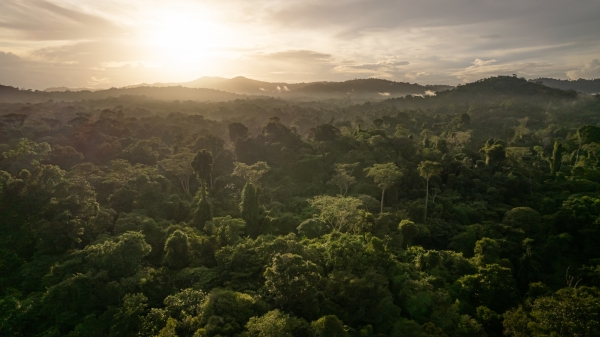
Study: Conservation actions highly effective at halting, reversing biodiversity loss
A new study, led and contributed to by Arizona State University faculty, provides the strongest evidence to date that not only is nature conservation successful, but that scaling up conservation…
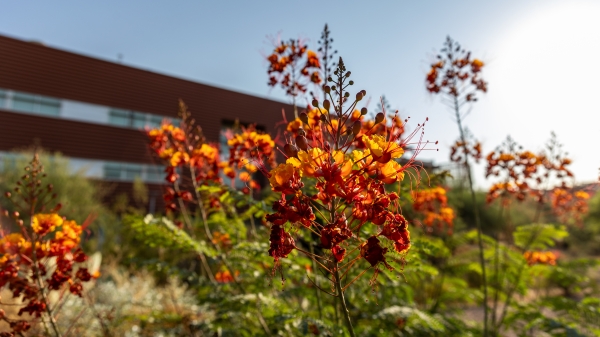
Barrett Honors College to host nature walks for science, relaxation
Barrett, The Honors College at Arizona State University is gearing up to participate in the City Nature Challenge (CNC) for the fourth consecutive year. This annual event, taking place April 26–29,…
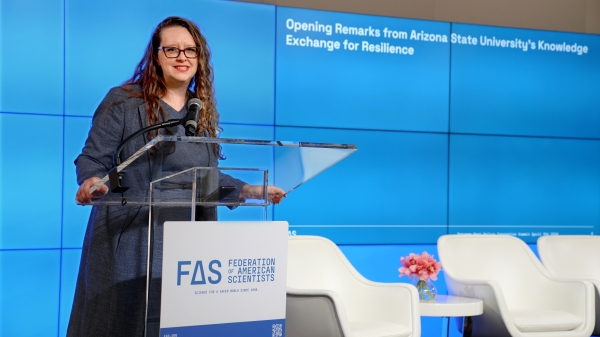
Arizona adapting to heat crisis with initiatives featured in ASU report
Arizona State University's Knowledge Exchange for Resilience, also known as KER, released its Recommendations Report on Extreme Heat Preparedness earlier this April during a summit in the nation's…
